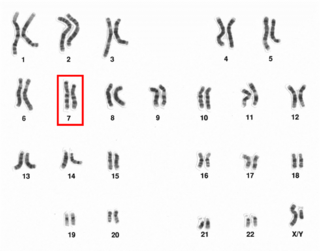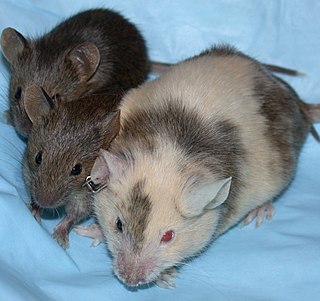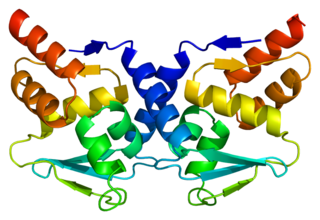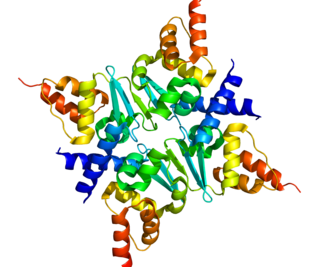Zinc finger protein 831 is a protein that in humans is encoded by the ZNF831 gene. [1]
Zinc finger protein 831 is a protein that in humans is encoded by the ZNF831 gene. [1]

EGR-1 also known as ZNF268 or NGFI-A is a protein that in humans is encoded by the EGR1 gene.

Chromosome 7 is one of the 23 pairs of chromosomes in humans, who normally have two copies of this chromosome. Chromosome 7 spans about 159 million base pairs and represents between 5 and 5.5 percent of the total DNA in cells.

Gene targeting is a genetic technique that uses homologous recombination to modify an endogenous gene. The method can be used to delete a gene, remove exons, add a gene and modify individual base pairs. Gene targeting can be permanent or conditional. Conditions can be a specific time during development / life of the organism or limitation to a specific tissue, for example. Gene targeting requires the creation of a specific vector for each gene of interest. However, it can be used for any gene, regardless of transcriptional activity or gene size.

Zinc finger E-box-binding homeobox 2 is a protein that in humans is encoded by the ZEB2 gene. The ZEB2 protein is a transcription factor that plays a role in the transforming growth factor β (TGFβ) signaling pathways that are essential during early fetal development.

B-cell lymphoma 6 protein is a protein that in humans is encoded by the BCL6 gene. Like BCL2, BCL3, BCL5, BCL7A, BCL9 and BCL10, it has clinical significance in lymphoma.

Zinc finger and BTB domain-containing protein 16 is a protein that in humans is encoded by the ZBTB16 gene.

Early growth response protein 2 is a protein that in humans is encoded by the EGR2 gene. EGR2 is a transcription regulatory factor, containing three zinc finger DNA-binding sites, and is highly expressed in a population of migrating neural crest cells. It is later expressed in the neural crest derived cells of the cranial ganglion. The protein encoded by Krox20 contains two cys2his2-type zinc fingers. Krox20 gene expression is restricted to the early hindbrain development. It is evolutionarily conserved in vertebrates, humans, mice, chicks, and zebra fish. In addition, the amino acid sequence and most aspects of the embryonic gene pattern is conserved among vertebrates, further implicating its role in hindbrain development. When the Krox20 is deleted in mice, the protein coding ability of the Krox20 gene is diminished. These mice are unable to survive after birth and exhibit major hindbrain defects. These defects include but are not limited to defects in formation of cranial sensory ganglia, partial fusion of the trigeminal nerve (V) with the facial (VII) and auditory (VII) nerves, the proximal nerve roots coming off of these ganglia were disorganized and intertwined among one another as they entered the brainstem, and there was fusion of the glossopharyngeal (IX) nerve complex.

Protein CBFA2T1 is a protein that in humans is encoded by the RUNX1T1 gene.

Zinc finger E-box-binding homeobox 1 is a protein that in humans is encoded by the ZEB1 gene.

Zinc finger protein PLAGL1 is a protein that in humans is encoded by the PLAGL1 gene.

Zinc finger and BTB domain-containing protein 17 is a protein that in humans is encoded by the ZBTB17 gene.

Zinc finger protein Aiolos also known as Ikaros family zinc finger protein 3 is a protein that in humans is encoded by the IKZF3 gene.

B-cell lymphoma/leukemia 11A is a protein that in humans is encoded by the BCL11A gene.

Zinc finger protein 74 is a protein that in humans is encoded by the ZNF74 gene. Schizophrenia susceptibility has been associated with a mutation in this protein.

Zinc finger protein 202 is a transcription factor first associated with breast cancer. It is a protein that, in humans, is encoded by the ZNF202 gene.

POZ-, AT hook-, and zinc finger-containing protein 1 is a protein that in humans is encoded by the PATZ1 gene.

Zinc finger and BTB domain-containing protein 32 is a protein that in humans is encoded by the 1960 bp ZBTB32 gene. The 52 kDa protein is a transcriptional repressor and the gene is expressed in T and B cells upon activation, but also significantly in testis cells. It is a member of the Poxviruses and Zinc-finger (POZ) and Krüppel (POK) family of proteins, and was identified in multiple screens involving either immune cell tumorigenesis or immune cell development.

Zinc finger protein 804A is a protein that in humans is encoded by the ZNF804A gene. The human gene maps to chromosome 2 q32.1 and consists of 4 exons that code for a protein of 1210 amino acids.

PR domain zinc finger protein 9 is a protein that in humans is encoded by the PRDM9 gene. PRDM9 is responsible for positioning recombination hotspots during meiosis by binding a DNA sequence motif encoded in its zinc finger domain. PRDM9 is the only speciation gene found so far in mammals, and is one of the fastest evolving genes in the genome.

Zinc finger protein 521 is a protein that in humans is encoded by the ZNF521 gene.
| | This article on a gene on human chromosome 20 is a stub. You can help Wikipedia by expanding it. |